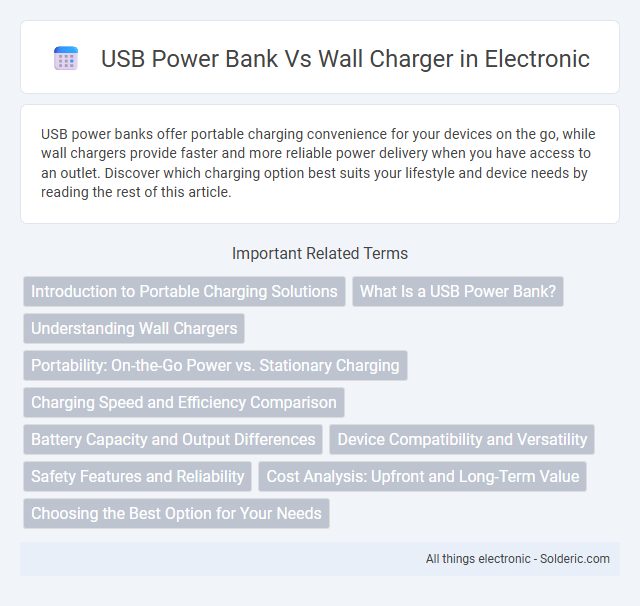USB power banks offer portable charging convenience for your devices on the go, while wall chargers provide faster and more reliable power delivery when you have access to an outlet. Discover which charging option best suits your lifestyle and device needs by reading the rest of this article.
Comparison Table
| Feature | USB Power Bank | Wall Charger |
|---|---|---|
| Portability | Highly portable, can charge devices anywhere | Requires power outlet, limited portability |
| Power Source | Internal battery, rechargeable | Direct power from electrical outlet |
| Charging Capacity | Varies (5,000mAh to 30,000mAh+) | Depends on outlet, generally unlimited |
| Charging Speed | Moderate, depends on power bank output (5W to 30W+) | Faster with high wattage chargers (18W to 100W+) |
| Usage | Ideal for travel, outdoor use, emergencies | Best for home, office, and fixed locations |
| Number of Devices | Multiple USB ports on some models | Multiple ports but limited by power outlet |
| Cost | Moderate to high depending on capacity | Generally low to moderate |
| Dependency | Needs recharging via outlet or device | Works anytime with power supply |
Introduction to Portable Charging Solutions
USB power banks offer portable charging solutions that provide on-the-go power without the need for an electrical outlet, making them ideal for travel and outdoor use. Wall chargers deliver consistent, high-speed charging when plugged directly into an electrical source, supporting fast recharge for devices at home or office. You can enhance your device's battery life conveniently by choosing the charging solution that fits your mobility and power needs.
What Is a USB Power Bank?
A USB power bank is a portable device designed to store electrical energy in an internal battery, allowing users to charge smartphones, tablets, and other USB-powered gadgets on the go. It typically features multiple USB output ports and varying capacity ranges measured in milliampere-hours (mAh), which determine how many times it can recharge devices. Unlike wall chargers that require a fixed power outlet, USB power banks provide convenient and mobile power solutions for wireless charging anywhere.
Understanding Wall Chargers
Wall chargers convert AC power from an electrical outlet into a stable DC output to recharge devices efficiently, with varying wattages suited for smartphones, tablets, and laptops. They provide continuous power supply without concerns about battery capacity, making them ideal for home or office use. Understanding your wall charger's voltage and amperage helps optimize charging speed and protect your devices from damage.
Portability: On-the-Go Power vs. Stationary Charging
USB power banks offer unparalleled portability, providing on-the-go power for smartphones, tablets, and other devices without the need for a stationary outlet. Wall chargers excel in delivering consistent, high-wattage charging but require access to an electrical socket, limiting their use to fixed locations. For travelers and outdoor enthusiasts, power banks serve as essential mobile energy sources, while wall chargers remain ideal for home or office environments.
Charging Speed and Efficiency Comparison
USB power banks typically offer slower charging speeds compared to wall chargers due to limited power output and internal battery capacity. Wall chargers can deliver higher wattage directly from the power source, resulting in faster and more efficient device charging. Choosing the right option depends on your need for mobility versus optimal charging speed.
Battery Capacity and Output Differences
USB power banks offer varying battery capacities, typically ranging from 5,000mAh to 30,000mAh, allowing multiple device charges on the go, while wall chargers rely on continuous AC power without built-in storage. Output differences include power banks often providing USB-A or USB-C ports with output voltages of 5V and currents from 1A to 3A, whereas wall chargers can deliver higher wattages, supporting fast charging with outputs up to 100W or more. Your choice depends on whether portability with stored energy or maximum charging speed from a fixed power source better suits your device usage needs.
Device Compatibility and Versatility
USB power banks offer exceptional device compatibility and versatility by supporting a wide range of devices such as smartphones, tablets, Bluetooth earbuds, and even some laptops through multiple output ports and varying voltage levels. Wall chargers provide reliable, high-speed charging for devices directly connected to an electrical outlet but may lack the flexibility to charge multiple device types or function on-the-go. Your choice depends on whether you prioritize portability and multi-device charging or stationary, consistent power supply.
Safety Features and Reliability
USB power banks incorporate advanced safety features such as overcharge protection, short-circuit prevention, and temperature control to ensure device and user safety during mobile use. Wall chargers often include built-in surge protection, voltage regulation, and certified materials that contribute to consistent and reliable power delivery directly from electrical outlets. Choosing a certified product with compliance to safety standards like UL or CE enhances reliability and mitigates risks associated with electrical faults in both USB power banks and wall chargers.
Cost Analysis: Upfront and Long-Term Value
USB power banks typically require a higher upfront cost compared to basic wall chargers, but they offer portability and on-the-go charging that can reduce reliance on electrical outlets. Wall chargers generally have a lower initial price and provide consistent, faster charging speeds, which benefits long-term use for stationary devices. Evaluating cost-efficiency hinges on user needs--power banks add value through convenience and emergency power, while wall chargers deliver sustained performance and lower replacement frequency.
Choosing the Best Option for Your Needs
Choosing between a USB power bank and a wall charger depends on your lifestyle and power requirements. A USB power bank offers portability and emergency power on the go, ideal for travel or outdoor activities, while a wall charger provides faster, consistent charging when you have access to an electrical outlet. Assess your daily usage patterns and the number of devices you need to charge to determine the best option for your needs.
USB power bank vs wall charger Infographic

 solderic.com
solderic.com